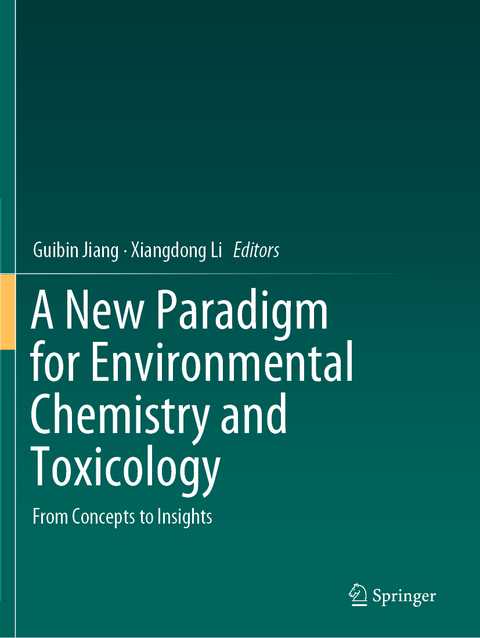
A New Paradigm for Environmental Chemistry and Toxicology
Springer Verlag, Singapore
978-981-13-9449-2 (ISBN)
The book also features a forward-looking perspective on emerging environmental issues that call for new research and regulatory paradigms, laying the groundwork for future advances in the broad field of environmental chemistry and toxicology.
Written by respected authorities in the field, A New Paradigm for Environmental Chemistry and Toxicology - From Concepts to Insights will offer an invaluable reference guide for concerned researchers and professional practitioners for years to come.
Guibin Jiang Professor Guibin Jiang is Director of the State Key Laboratory of Environmental Chemistry and Ecotoxicology, Dean of the College of Resources and Environment, University of Chinese Academy of Sciences (CAS), and President of the China Association for Instrumental Analysis. He received his BSc from the Department of Chemistry, Shan Dong University, in 1981, his MSc from the Institute of Environmental Chemistry, CAS, in 1987, and his PhD from the Research Center for Eco-Environmental Sciences (RCEES, CAS) in 1991. Prof. Jiang’s research mainly focuses on Environmental Chemistry and Toxicology. He has published over 700 articles in leading scientific journals and is the author of 15 scientific books. As an invited plenary or keynote speaker, he has presented at more than 600 international meetings, institutes and universities. He is a three-time recipient of the Chinese National Natural Science Award. Professor Jiang is the former Deputy-Director and Director-General of RCEES (2001-2017). He is currently an Associate Editor for Environmental Science and Technology (ES&T, 2006-). He was elected as a member of the Chinese Academy of Sciences (2009), a fellow of the Third World Academy of Sciences (TWAS, 2012), and a fellow of the Royal Society of Chemistry (FRSC, 2014). Xiang-dong Li Professor Xiang-dong Li is Director of the Research Institute of Sustainable Urban Development, Chair Professor of Environmental Science and Technology at the Department of Civil & Environmental Engineering, and Associate Dean (Research) of the Faculty of Construction and Environment, Hong Kong Polytechnic University. He obtained his BSc in Earth Sciences and his MSc in Geochemistry from Nanjing University, and his PhD in Environmental Technology from Imperial College London. Prof. Li’s major research interests include regional pollution, urban environmental studies, and remediation of contaminated soils. He has published more than 200 papers in leading international journals, and is one of the highest-cited researchers in Environment/Ecology on the Web of Science database. He was awarded the Outstanding Young Researcher (Oversea) Fund from the Natural Science Foundation of China (NSFC) in 2007. Professor Li is a past president (2011-2013) of the International Society of Environmental Geochemistry and Health (SEGH). He is currently an Associate Editor for Environmental Science and Technology (ES&T). Prof. Li is also an associate editor and editorial board member for several other international journals in related research fields.
Part 1. The Exposome: Pursuing the Totality of Exposure.- Chapter 1. The Exposome: Pursuing the Totality of Exposure.- Part 2. Insights into Exposure Sources, Processes, and Impacts.- Chapter 2. In Situ Passive Sampling Techniques for Monitoring Environmental Mixture Exposure.- Chapter 3. In Vivo SPME for Bioanalysis in Environmental Monitoring and Toxicology.- Chapter 4. Dose-Dependent Transcriptomic Approach for Mechanistic Screening in Chemical Risk Assessment.- Chapter 5. Synchrotron-Based Techniques for the Quantification, Imaging, Speciation, and Structure Characterization of Metals in Environmental and Biological Samples.- Chapter 6. Modelling and Computational Approaches for Exposure, Processes, and Impacts High-Throughput Screening and Hazard Testing Prioritization.- Chapter 7. Mixture Modelling and Effect-Directed Analysis for Identification of Chemicals, Mixtures and Effects of Concern.- Chapter 8. Mining Population Exposure and Community Health via Wastewater-Based Epidemiology.- Chapter 9. Modeling Human Exposure to Persistent Organic Pollutants.- Part 3. Solutions for Mitigating Hazardous Exposures.- Chapter 10. The Development and Challenges of Oxidative Abatement for Contaminants of Emerging Concern.- Chapter 11. Biochar for Water and Soil Remediation: Production, Characterization, and Application.- Chapter 12. Nanotechnology as a Key Enabler for Effective Environmental Remediation Technologies.- Part 4. Emerging Issues of Future Concern.- Chapter 13. Disinfection: A Trade-Off Between Microbial and Chemical Risks.- Chapter 14. Plastic and Microplastic Pollution: From Ocean Smog to Planetary Boundary Threats.- Chapter 15. Size and Composition Matters: From Engineered Nanoparticles to Ambient Fine Particles.- Part 5. Transforming Environmental Chemistry and Toxicology to Meet the Anthropocene Sustainability Challenges Beyond Silent Spring.- Chapter 16. Transforming Environmental Chemistry and Toxicology to Meet the Anthropocene Sustainability Challenges Beyond Silent Spring
| Erscheinungsdatum | 30.08.2020 |
|---|---|
| Zusatzinfo | 62 Illustrations, color; 5 Illustrations, black and white; X, 276 p. 67 illus., 62 illus. in color. |
| Verlagsort | Singapore |
| Sprache | englisch |
| Maße | 210 x 279 mm |
| Themenwelt | Sachbuch/Ratgeber ► Natur / Technik ► Natur / Ökologie |
| Naturwissenschaften ► Biologie ► Ökologie / Naturschutz | |
| Naturwissenschaften ► Chemie ► Technische Chemie | |
| Technik ► Umwelttechnik / Biotechnologie | |
| Schlagworte | Analytical Chemistry • Environmental Health • Environmental issue • Pollution Remediation • Predictive toxicology |
| ISBN-10 | 981-13-9449-0 / 9811394490 |
| ISBN-13 | 978-981-13-9449-2 / 9789811394492 |
| Zustand | Neuware |
| Haben Sie eine Frage zum Produkt? |
aus dem Bereich


